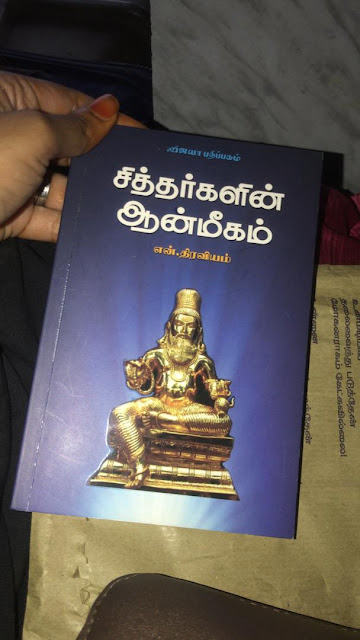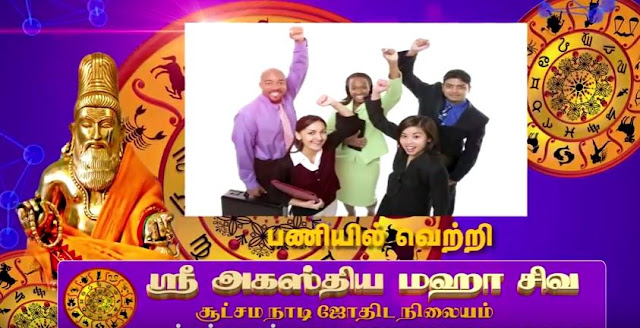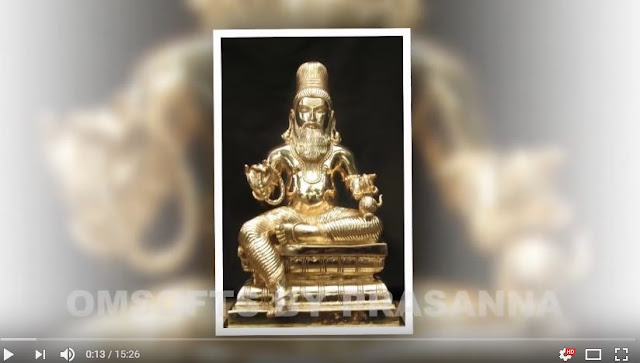How can we write a biography of our father or any other person for the matter unless we know him well? With whatever little he has told us and the other facts gathered from the others around him, we set to write one. Similarly, how do we write the origin of Agathiyar? How do you write the origin of Erai, Kadavul, or God?
When a cousin of mine, who came to know that I was worshipping Agathiyar, mentioned a couple of episodes from Agathiyar's life that he had read, asked me if they were true, I simply replied to him that I do not know. If someone was to ask me who was Agathiyar I would not have a satisfactory answer for him, although I worshipped him. All I know is that I was asked to worship him which I did. As to the question of what have you attained or gained through his worship, I can only reply that we do not come to worship expecting results or its fruits. That would be making a deal or doing business with the other. Worship has to be out of love for the other, irrespective if we gain or lose. Worship is respect that has delved into love for another. This untold love drives one to worship the other. The subject of worship can be another person, the parents, a guide or guru or the invisible prevalent energy that we give forms and names to.
I was given a name and a form to worship too. It was Agathiyar. He, through a Nadi reading, asked me to come to his path, the Siddha Margam and had Sivabalan immediately pass me his painting to worship. My worship of him began that day. A year later he showed me my first guru Supramania Swami. Three years later he showed me, my second guru, Tavayogi Thangarasan Adigal. He did show me to others too but I put my feet down saying I want no more gurus in the physical form. Then he came as the guru in the form of a bronze idol. Can an idol be a guru then? Can an idol teach another? I would suggest you find out for yourselves by worshipping an idol of your favourite deity or guru. No amount of learning or discussion can come close to what experience can offer. One has to experience to know. The Siddha path is one of experience. Learning the practical way; that of walking the path.
Rather than have me sit in front of him and running through the volumes of literature and songs of the Siddhas, Tavayogi took me on a walk, first around his ashram, then into jungles, caves, and hills. He took me to the places where the Siddhas had placed their feet. Their energies that were present at these places, transformed into tiny miracles. Both nature and places of worship energize the body and soul.
After 17 years, I surprise myself that I am still on the path where many have left for more enticing and gratifying paths. The days of searching and seeking has ended. The divine has come to stay.
AVM Agathiyar who has adorned the covers of books, leaflets, magazines and billboards, has gained popularity making a brief appearance in numerous video on YouTube and a recent movie too.
Even before these gurus trod his path, Agathiyar had literally walked on the face of the earth. Skimming through several documents brings us to understand that Agathiyar having been summoned by Lord Shiva to bring a check and balance while correcting the tilt that had occurred when all the Gods and Goddesses, Devas and Devis, Rishis and their wives, Siddhas and their wives, and all their attendants had converged at one spot in the north to witness the holy matrimony of Siva Parvathy. Agathiyar travelled to the south and placed his thumb on the ground at Agasthiyampalli and pressed it gently into the ground. The earth was brought to a state of balance. After completing his assigned tasks and receiving the darshan of both Lord Siva and Parvathy in their marital state, he moved to serve mankind and all. His journey and his many encounters have been documented in numerous works and songs of the Siddhas.
In writing about the "Origin & Development of Siddha System of Medicine", Dr Mandayam Kumar writes the following,
It would not be out of place here to give a short narrative about Sage Agastya at the beginning of Kali era, since when our present civilization has its origin. Sage Agastya is stated to have been born nearly 5000 years prior to the commencement of Kali Yuga, at a place in Gujarat, as the son of Bhargava and Indumathi who followed the traditional Pasupatha cult which was widely prevalent at that time.
Sage Agastya’s text explains about a great calamity he had visualized, equivalent to a ‘Pralaya’, which took place about 1600 years before the Kali era.The text referred to writings on an old palm leaf,
During a search for different literature on our ancient medical science in India, a palm leaf manuscript in Tamil dating back to 3100 B.C. could be traced, giving a detailed account of the intensive research work done by the great Siddhas of South India.
The entire narration in the Siddha text is attributed to Sage Agastya and is given in the form of a discourse between him and Pulasthya, one of his intimate disciples.
Continuing from the texts,
It is stated that there was an explosion in the planet Mars by which enormous pieces of burning boulders and earth were thrown into space. One among such fairly big pieces was attracted towards the earth and hit the Antarctic region. Due to this collusion, the Earth’s path and axis were greatly disturbed and it took a long time for earth to settle itself and resume its normal course. Besides, the sea water rose to a great height submerging a major portion of the land south of India and spreading water all over, bringing in the end of all civilization which existed at that time. This collusion and disturbance caused a drift in the position of the land, dividing it into five parts as it stands at present. Only a handful of people were saved during this calamity and were scattered all over the world. It took nearly 1500 years for the earth to come to a form. It has been reckoned that the Kali era started from the midnight of the 18th February, 3102 B.C.
Sage Agastya, with his cosmic intellect, was able to visualize that Lord Siva and his consort, Uma had willed to be born on earth in the form of Dakshina Murthy and Shenbhaga Devi and selected their abode at the Podigai Malai of the Courtalam range, north of Kanya Kumari. Eleven years after the commencement of the Kali era, great seers like Agastya, Nandeeswara, Pasupathi, Vyaghrapada and Patanjali gathered at Mahadeva Giri of the Courtalam hills, along with Lord Muruga, son of Siva and Parvathi, and met Dakshina Murthy and Shenbhaga Devi seeking their guidance.
It is stated that Lord Dakshina Murthy instructed these Rishis to revive the ancient knowledge of philosophy and science and propagate them suitably for the wellbeing of humanity. Accordingly, each of them chose a different branch and recorded their knowledge on palm leaves, compiled in the form of texts. This great task was carried out at a place known as Alagan Kulam in Ramnad District of Tamil Nadu.
Agastya was particularly assigned with the task of taking necessary steps to propagate the ancient knowledge with all its branches throughout the world in a suitable manner according to the needs of circumstances. Thus, the entire recorded palm leaf texts were handed over by Lord Dakshina Murthy to Sage Agastya on Tuesday, the 21st day of Karthigai (Solar month) in Easwara Samvatsara of this Kali Yuga.
Having this great task before him, Agastya had to select eminent persons for the propagation of the knowledge. Under the guidance of Lord Muruga, an institution was formed near the main waterfalls at Courtalam adjacent to the Temple. The institution was started with the help of the great philosopher-scientist of China, the well-known Bhogar, and an eminent scholar from Malaysia by name Nandi Devar (subsequently named as Theriyar). Besides, Yugimuni, Pulappani, Pambatti Siddhar, Pulasthya and Kappiyan also joined them. With the help of these scholars, Sage Agastya conducted a conference at Courtalam and founded a hospital and research institute for the propagation of medical science.
At Thorana Malai Research Institute, provision was made for teaching students from different parts of the world in five distinctive subjects in a systematic manner.
Firstly, they were taught philosophy to understand the relationship of soul and matter, the process of evolution and attainment of reality.
Secondly, they were trained in different branches of Yoga to attain perfection or Siddhi through the process of meditation.
Thirdly, they were thoroughly taught Astronomy and Astrology, which are inter-related.
Fourthly, they were trained in alchemy, i.e. physical and chemical properties of elements.
The last subject to be taught was the Science of Medicine. With these they would be thorough in their diagnostic capacities through the Nadi system, i.e., pulse reading.At this institute
Bhogar took up research on medicines with chemicals, minerals, gems and salts.
Nandi Devar (Theriyar) was the head of the department of surgery;
Yugi Muni was in charge of Ayurvedic preparations and medicines attached with herbarium; and
Pulasthya and Kappiyan were in charge of recording the results of different research works conducted at the institute. Apart from treating the general public the hospital had the facility to treat wounded warriors with surgery. Replacement of limbs and organs were also taken up including brain and heart surgery.At Paradesi Kundai on Courtalam hills, an Ayurvedic institution was established with a herbarium attached to it under the able guidance of Yugi Muni. Botanical research was also taken up here, bringing about various high-breed varieties of plants, flowers, fruits, etc. Even silk cocoons with different colors were developed here by rearing the larvae with different chemicals as their food. The art of sericulture is elaborately explained in their records.
At Maruda Malai near Coimbatore, Pambatti Siddhar took up research work on poisonous snakes for the utilization of the venom in the treatment of various diseases. During the course of such a research, the administration of medicines through injections was also developed with the help of syringe and needle. Particular care was taken to design the needle. A special alloy of copper and gold was adopted in the manufacture of these needles. The mode of treatment through injections was considered as Raja Vaidya or king of treatments and it is stated that Chinese and Ethiopians widely used this art in their treatment.
Under the guidance of Bhogar an institution was established at Thiruparukundram near Madurai for research on minerals, salts, chemicals, etc., converting them to Bhasmas and Sindhuras for easy assimilation with high potency. These Bhasmas and Sindhuras have high specific activity and are very effective in the treatment of chronic and acute diseases. Further the method of liquefying the metals and minerals was also developed here making them suitable for administering as injections. In addition, to find out the nature of toxicity and efficacy of these medicines that they were first tried on animals. For this purpose, an animal house was established at Pasumalai adjacent to Thiruparukundram.
The surgical section attached to the hospital in Thorana Malai was headed by Nandi Devar who was well known as Theriyar. At this place, the preliminary training in the art of surgery was given through a special species of frogs called Therai. Hence, the department head was nicknamed as Theriyar – one who rears Therai frogs. Elaborate explanations are given about the method of surgery. Hygienic upkeep of the place, sterilization of instruments, different anesthetic preparations to suit the age of the patient and duration of surgery are adequately explained, besides giving various medicinal formulae for the quick healing of the surgical wound. It is mentioned that the thread taken out from the banana plant was used for the sutures in surgery. Special preparations used as local anesthesia are also explained in addition to disinfectants. Transplantations of foetus on animals were also tried at Pasumalai bringing in several varieties of animals. They had even tried plastic surgery for wounded soldiers.(Source: http://www.tknsiddha.com/medicine/origin/)
It is amazing to read about the extent the Siddhas went to, to bring solutions to mankind. Compassion for man drove them to research and come out with appropriate solutions. Even today they guide many in treating diseases, in solving problems, in various discoveries, and in numerous other fields.
P.Karthigayan in his "History of Medical & Spiritual Sciences of Siddhas of Tamil Nadu", published by notionpress.com, Chennai, 2016, lists the extensive fields of sciences and studies the Siddhas had carried out.
P.Karthigayan in his "History of Medical & Spiritual Sciences of Siddhas of Tamil Nadu", published by notionpress.com, Chennai, 2016, lists the extensive fields of sciences and studies the Siddhas had carried out.
Siddhas were pioneers of many scientific inventions and discoveries in ancient Tamil Land. Siddhas like Siva, Nandhi, Subramaniyar, Thirumoolar and Kaalaangi had shown special interest in health, longevity and immortality. Agathiyar had shown special interest in body concepts. Bhogar had shown special interst in physics. Chataimuni had shown special interst in alchemy. Konganar had shown special interest in aviation. Karuvoorar had shown special interest in metal castings. Jothimuni researched and perfected precious stones. Idaikkadar studied the cosmos.Karthikayan writes that the Siddhas believed that immortality was of dual nature, Athma Siddhi or spiritual immortality and Kaaya Siddhi or physical immortality. He continues,
The Siddha cult was a path of freedom in every respect. Each one took some theme of research and passed on his findings to the society through his disciples and literary records. The main focus of their reserch was the body and the cosmos. From them originated unusual schools of thought that differed from the regular streams of spirituality known to ancient civilizations, hence came to be regarded as mythology in later years.Only experience will prove otherwise. Walk the path to know.


































